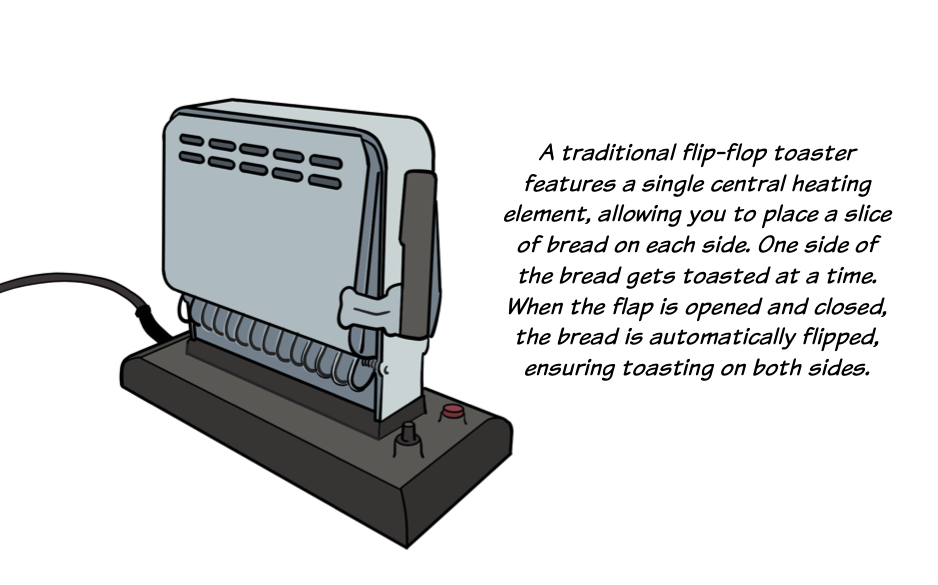…. the value it provides? The widely accepted definition of a system’s purpose was coined by Stafford Beer (2001) and states that the Purpose of a System is What It Does (POSIWID):
“According to the cybernetician, the purpose of a system is what it does. This is a basic dictum. It stands for bald fact, which makes a better starting point in seeking understanding than the familiar attributions of good intention, prejudices about expectations, moral judgment, or sheer ignorance of circumstances.”
For instance, consider the flip-flop toaster as depicted below. I much appreciate this toaster for its unique functionality—it toasts only on one side and lacks an auto-stop feature. You have to manual flip the bread and careful pay attention to get your toast just right. A beautiful small breakfast ritual.

A flip-flop toaster has a single heating element positioned in the center. When you insert a slice of bread into the toaster’s slots, it rests on a platform that can be flipped. Initially, one side of the bread is exposed to the heating element for toasting. Once that side is sufficiently toasted, the toaster’s flap is manually opened, causing the bread platform to flip over. This action exposes the un-toasted side of the bread to the heating element. Typically I flip the toast back and forth several times to get the desired level.

According to Beer’s definition, the purpose of this toaster is what it does. So, what does it do? A toaster is engineered to toast bread slices by subjecting them to radiant heat generated by an electric heating element. This radiant heat initiates the “Maillard reaction” in the bread, resulting in its browning and achieving a crispy texture. The purpose of the toaster is to toast bread. Ok.

What if the table is set differently? Would it make a difference? For example, if the table is set with more organically shaped bread, fruits, or vegetables. Yes, the toaster would still perform its primary function of toasting bread, but could you also use it to warm churros or roast part of a paprika? Does the purpose of the toaster remain the same? Well, obviously, the toaster’s main purpose actually is to provide me with a riveting distraction while everyone else enjoys a peaceful breakfast.

Now imagine one day the toaster taking an unexpected plunge out of an airplane and landing in the desert. It’s not as probable as an airplane door, but let’s indulge the scenario. Picture it standing there in the sand. What now is its purpose with no bread in sight for miles? Is it still toasting bread? Perhaps its shiny shell could double as a beacon, reflecting the sun’s rays. And if by chance, it were to sink only partially into the sand, with part of it still protruding, could its purpose be to offer some much-needed shade? With neither electricity nor bread in sight for miles, it does not toast bread.

In the previous examples, we observed a shift in the determination of the toaster’s purpose. Initially, the discussion centered around a technical explanation, focusing on the toaster’s internal mechanisms. However, as soon as the toaster was placed within a specific context, the answer to “what does the toaster do?” evolved to identifying the value it provides within that context. This shift highlights how the question “what does it do?” tends to trigger analytical thinking. Conversely, reframing the question to “what is its value?” redirects the conversation away from technical specifics and towards the broader context: Who benefits from the toaster’s functionality? Under what circumstances? What capabilities does it offer? When we prioritize value, the toaster’s purpose is identified by assessing the role it plays within its wider context.
“So what?” you may ask. “Are we just splitting hairs here? It might seem like mere semantics – after all, the concept of ‘doing’ inherently includes ‘providing value.’ Therefore, if the purpose of a system is what it does, then it already encompasses the value it offers.” Well, eh, ‘Jain’ in good Swiss-German (combining Ja – yes – and Nein – no), or ‘Ni’ in equally valid Swiss-Italian (combining No and Si). And, yes, perhaps this inclination is unique to me, influenced by my engineering background. So I asked around and although the sample size may not render the finding statistically significant, I must conclude that individuals with a technical or engineering background are more likely to focus on the object’s functionality, components, and inner workings. Those who have not, do not and tend to focus more on value rather than functionality. Regretfully, in the context of projects or business situations, it’s highly probable that the person you’re conversing with possesses precisely such a background.
Let’s imagine – and this is purely hypothetical, any resemblance to real-life situations being purely coincidental – that you’re either a CEO of a mid-sized company or a project manager leading a large-scale transformation initiative. Your goal is to modernize business and operations by transitioning to a cloud-based solution. What is the project’s purpose? Given that a project can be seen as a system of sorts, its purpose is defined by what it does. However, unfortunately, discussing what the project does often leads into discussions elaborating the minutiae of activities, planning, and execution, resulting in sifting through spreadsheets filled with ticket numbers, statuses, and delivery dates.The stated purpose of the project is to migrate to a cloud solution. In practical terms, what the project does is installing a new piece of technology. Conversely, if instead, you start by questioning the project’s value, the conversation takes a different turn. It maybe focusses on reducing the number of service calls, improving response times, and enhancing operational efficiency or expanding the business reach. The discussion most likely will ignore the “inner workings” of the project and shifts towards what the project brings to the larger whole, towards the value it offers. In essence, why it is valuable.
So, yes, while the purpose of a system is indeed what it does, it is about what it does to bring value to the larger whole that defines its purpose. Therefore, I prefer to emphasize this and specifically focus on what it does to bring value. In other words, the purpose of a system is the value it offers or affords.